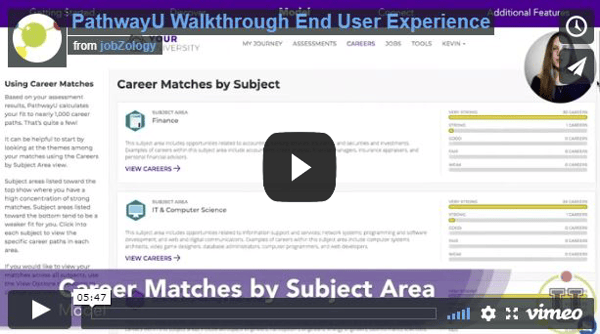Educating and Advising Online: 8 Tips To Share With Your Students
During the pandemic, many students postponed their fall semester plans. They chose to work (or maybe chill) rather than dive into a new world of remote learning.
Yet, with the promise of a vaccine, many students are feeling they’ve waited long enough and will be ready to return to class again this spring.
Your school is probably planning to continue with mostly or entirely online courses. Despite their desire to jump back in, many students may still find remote learning unsettling, or perhaps intimidating.
Here are 8 tips to help your students prepare for a successful return and thrive in the upcoming semester.
What can students expect from remote learning?
Students will probably see a similar variety of learning experiences and strategies as they would encounter in the classroom. However, they will be adapted to a virtual environment. For example:
- Video (e.g., live-streamed, or recorded lectures, links to YouTube, or Zoom conferences with the instructor and other students)
- Audio (e.g., podcasts and other recorded audio files)
- Text (e.g., announcements, written lectures, primary source articles, blog posts, and of course your textbooks)
Professors may also have live discussions where students will log in during the regular class time. Students may need to follow threaded discussion posts throughout the week.
Exams and quizzes might be proctored using a webcam, open-book, and open-note. These may be timed, or transformed into a “take-home” project.
There will be an adjustment period. But, most students tend to adapt quickly. In addition to professors and TAs, the Career Services department is a critical resource when supporting students through times of change.
And, with the proper career guidance systems in place, you will be just as available to respond to student questions as you were before--probably more so!
8 tips to help students succeed
- Familiarize yourself with the tech. Different instructors may use different platforms—most (maybe all) will use your school’s learning management system (Canvas, Moodle, Blackboard, etc.) but some may also use Zoom, MS Teams, or WebEx for conferencing; OneDrive, Dropbox, or Google Drive for sharing documents; YouTube or Twitch for live streams.
Instructors will let students know what platforms will be used—take a little time to acquaint yourself with the look, feel, and functions of each before you need to discuss them with students. Use the available help resources provided by each. There will be a learning curve, but you’ll figure things out quickly. - Focus on time management skills. Some courses will be taught in real-time, during the same hours a class meets in-person, but many others may not. The increased flexibility is a huge advantage of online learning but it can also create a major problem for students who are prone to procrastination, struggle to stick to a routine, or need frequent in-class reminders for when assignments are due.
Encourage students to frequently review the most updated syllabus for each of their courses, and to develop a week-by-week plan for completing major assignments. Instruct them to make a daily “To Do” list and enjoy checking tasks off as they complete them. Remind students to read (!) the announcements their instructor posts and adjust their plans accordingly. It takes effort for students to develop good time management habits but now is a perfect time to help them hone those skills. Their future selves will thank them! - Help establish a good study space. To the extent possible, encourage students to claim a space that offers relative peace and quiet, free from distractions like TV or conversations with roommates or family. Help students establish “learning times” during which they silence their phones, turn off alerts, and keep their browsers, games, and social media off. They can use noise-canceling headphones if they have them.
Perhaps, they need to consider ergonomics, adjust their chair, keyboard, and screen position so they are comfortable. Encourage them to adjust their lighting to minimize eye strain, and to brew some coffee or tea! - Promote active engagement. Whether in-person or online, active learning is effective learning. The online environment generally lends itself well to this. However, if classes no longer require students to “be present” at a specific time, encourage them to choose times to engage with material when they know they are usually alert and motivated.
Prompt students to throw themselves into the discussion boards (figuratively, please) and to ask thoughtful questions. Remind them to view videos and take vigorous notes, ideally by hand—and to quiz themselves frequently. Urge them to spread studying across several days rather than cramming in one night. Remind students to use all the resources available to them until they are confident they’ve grasped the material. It’s more important now than it ever has been to nudge students and encourage them to reach out if they are struggling or have concerns. - Communication skills are key in distance learning. Professors, TAs, and career services professionals are available and willing to help but they won’t be able to pick up on nonverbal cues like looks of confusion on a student’s face. It is important to practice extra verbal communication and reach out.
Remind students of this too. Encourage them to review the syllabus for the best ways to interact with a particular professor or TA—e.g., email, discussion groups, live chat office hours, phone, text, Skype. Make sure they know how to reach your career services department. - Exercise patience. We’re all in this together! Some students are not accustomed to online learning, and some professors are still new to online teaching. We are all doing our best to make this pandemic learning period work well but there will likely be a few hiccups along the way. Online platforms may not always work like they are supposed to (especially during times of increased traffic). If and when this happens, help your students do their best to manage their frustration. Remind them that their professors and TAs are committed to being patient as well. Remind your students to practice a little extra patience and compassion!
- Reciprocate and share resources. Consistently reach out and remind students: Even if your physical campus remains mostly closed, the same offices that work to serve students are still available to help. Do they have advising questions? Students can reach out to the advising office. Are they concerned about their health? Reach out to the campus health office. Experiencing tons of stress? Call the college counseling center.
This may be an excellent time for students to interact with their college career center if they are struggling with what the current uncertainty means for their career decision-making. You may even offer an online assessment and counseling tool like PathwayU, which can help steer students toward a career path that best fits them. - Motivate students to remain positive. Remind your students: They are in the driver’s seat of their own education. They can turn this period of online learning into an opportunity to thrive or an excuse to fail. They can seek ways to “game the system,” or they can honor their desire to be a person of integrity. Encourage them to think of themselves as mature, independent adults who are motivated to optimize their potential, and to develop and express their gifts in ways that make the world better. After all, that’s why they are pursuing a degree! Urge them to leverage their internal motivation to do their best, and to do it honestly.
Watch our 5-minute demo video to see PathwayU in action!

-1.png?width=288&height=67&name=PathwayU_PGLogo%20(1)-1.png)



